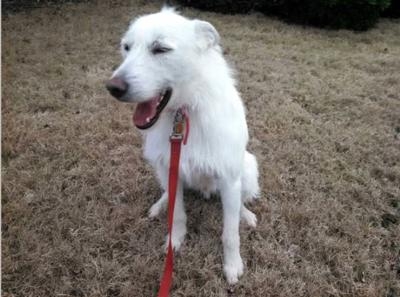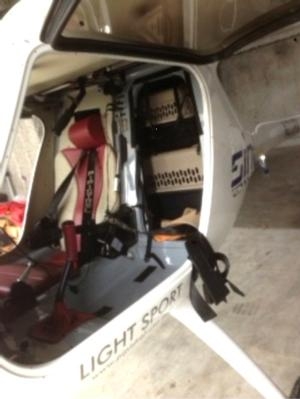Waiting For His Own Airplane So He Can Get In On The Effort
Every day thousands of dogs are abandoned, put in shelters and killed when nobody adopts them. But there are still some people – more every day, in fact – who do not accept this and are rescuing dogs by taking them to be adopted in no-kill areas of the country. There are hundreds of people driving large vehicles for days or flying aircraft that burn 10 gallons of fuel per hour or even more - to rescue dogs. But there might be a simpler and less expensive possibility.

This story begins with Greg Lawrence from Sarasota, Florida, who has been flying for more than 50 years. Greg is culturally deaf. He has been deaf since infancy with excellent oral skills and now has a Cochlear implant and "normal" hearing with 98% speech discrimination. Being deaf meant that Greg has had several guide dogs throughout his life. Tee is his current Guide Dog. Greg is also one of the people who try to rescue shelter dogs, otherwise destined to be killed, by trying to find them new homes.
Woofie is a 1 1/2 year old, 75 pound mix-Wolfhound, who was abandoned to a high-kill shelter in Alabama. Kimberly James from San Antonio, Texas, found Woofie on the Internet and wanted to adopt him, so she posted an entry to the Pilots N Paws web page.
Pilots N Paws is a non-profit organization which serves as a meeting place for those who rescue, shelter or foster animals, and volunteer pilots and plane owners willing to assist with the transportation of animals.

Greg was willing to fly for Kimberly and he had time, but no aircraft ... his Pipistrel was still on order. For several days it was looking as though Woofie was going to die in Alabama. When it already looked as though nothing could be done anymore, Greg suggested to Kimberly: "Rescuing dogs is a cowboy thing to do, look for a pilot in Texas". Kimberly did and the whole thing came together almost instantly. It was a long and complex operation. Woofie was rescued in 5 legs over 3 days, flying in 3 different aircraft: a Cherokee 180, a Cherokee Arrow and a Cirrus SR22, all burning 10 gallons per hour or more of avgas... but it was successful and today Woofie is in his forever home in San Antonio!
According to Pipistrel, who provided this story, Greg is still waiting for his aircraft, but he and his Guide Dog Tee are already a pack, doing everything in their power to rescue as many dogs as possible. Every day they get several notices from Pilots N Paws about dogs that need to be rescued, so Greg is establishing contacts like Kimberly all over the country. The dogs are getting rescued, but often with a lot of complications and at high expenses, requiring many financial donations. "All this is greatly appreciated," says Greg, "But it's not necessary! We could have rescued Woofie in a few hours, using less than half as much gas - auto gas, not aviation fuel - if we could fly a Pipistrel!"
And indeed one of Greg's customers, Mr. John Stewart, researched every aircraft imaginable for the purpose of rescuing dogs - and finally ordered a Virus SW. "The Pipistrel Virus, Virus SW, and Sinus are unique for dog rescue given their exceptional economy and range," says Mr. Stewart, "Especially with the Virus SW easily pulling pups through the sky with the Rotax 912 iS Sport engine, which adds enough range even for non-stops from the Southeastern United States, where there are countless dogs waiting dismally, to New England, where there is considerable demand for rescue dogs and especially puppies. While other aircraft are suitable for carrying larger numbers of dogs, the Pipistrel can fit a niche for rescuing puppies, small dogs, or possibly a larger one - if utilizing some of the space with the passenger seat removed and the dog secure. Lastly, the favorable glide ratios of Pipistrel aircraft provide a safety advantage for locating an alternative airport if the dogs are flown at a lower altitude
(to lessen ear discomfort for dogs). So here is yet another use of a Pipistrel motor-glider!"

And how do you rescue dogs in a tiny little Pipistrel aircraft, you might ask? Well, if there is room for 200 pound and 6 ft, 6 inch people where the passenger seat normally is, there surely is enough room for a 150 pound dog crate - or several smaller ones. The benefit of this kind of transport is rescuing the dog in a few hours instead of days, making the travel less stressful.
"Being isolated in a cage is very stressful to a dog," says Greg. "Dogs being rescued are spending days or even weeks alone in a crate while they are transported. We will use crates also, but Tee will be in the crate while flying, thus making the dog part of a pack (dogs travel in packs). When the rescued dog is in a company of another dog, who is used to flying and therefore calm, it will be a lot less stressed."
Greg is optimistic about being able to rescue many more dogs with Pipistrel aircraft in the future.
(Images provided by Pipistrel)
 Unfortunate... ANN/SportPlane Resource Guide Adds To Cautionary Advisories
Unfortunate... ANN/SportPlane Resource Guide Adds To Cautionary Advisories ANN FAQ: Turn On Post Notifications
ANN FAQ: Turn On Post Notifications ANN's Daily Aero-Term (04.29.24): Visual Approach Slope Indicator (VASI)
ANN's Daily Aero-Term (04.29.24): Visual Approach Slope Indicator (VASI) ANN's Daily Aero-Term (04.28.24): Airport Marking Aids
ANN's Daily Aero-Term (04.28.24): Airport Marking Aids ANN's Daily Aero-Linx (04.28.24)
ANN's Daily Aero-Linx (04.28.24)





